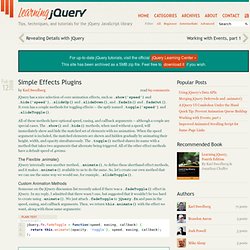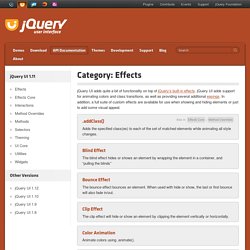

Creating a fading header. Since I’ve gotten lots of emails asking me how I created the fading header graphic for Bits and Pixels I’m going to write a tutorial explaining how created the effect.

I’ll be creating the effect using some basic XHTML and CSS and some unobtrusive Javascript, using the jQuery library, for the effect itself. I’ve chosen jQuery because I like the way it’s built, find the elements you wish and do something with them. If you prefer another library, or just don’t want to use any library at all, that’s fine too (but you’ll need to write your own fade-function). The code shouldn’t differ too much, and since I’ll be explaining all the steps you shouldn’t have any problems translating it to the toolkit of your choice. The image This is the image that I’ll be using. The HTML and CSS The HTML is very straight forward. Now we’ll add some CSS to style our header and give it some imagery Here’s an example showing what we’ve got so far. Here’s an example of what we’ve got so far. Simple Effects Plugins.
jQuery has a nice selection of core animation effects, such as .show('speed') and .hide('speed'), .slideUp() and .slideDown(), and .fadeIn() and .fadeOut().

It even has a couple methods for toggling effects — the aptly named .toggle('speed') and .slideToggle(). All of these methods have optional speed, easing, and callback arguments — although a couple are special cases. The .show() and .hide() methods, when used without a speed, will immediately show and hide the matched set of elements with no animation. When the speed argument is included, the matched elements are shown and hidden gradually by animating their height, width, and opacity simultaneously.
The .toggle() method shares its name with a method that takes two arguments that alternate being triggered. The Flexible .animate() jQuery internally uses another method, .animate(), to define these shorthand effect methods, and it makes .animate() available to us to do the same. Custom Animation Methods JavaScript: Update Try it out: jQuery effects, 150+ best for web developers and designers Web Design Shock. Since the arrival of the jQuery library, the life of JavaScript programmers have gotten a lot easier because now it’s simpler to develop web 2.0 applications.
With jQuery, the programmers can keep their code organized and concise, which is the major slogan of the library, “write less, do more”. You can utilize jQuery to handle events, generate animations, and even add an Ajax support into your web applications in a very easy way. Certainly you can use JavaScript to execute all the jQuery functions, but if you use it, your programming times will reduce and your effectiveness will increase, and that’s the real magic of jQuery.
On this roundup we will show you the most captivating and creative jQuery tools and effects to inspire you, from animations to slideshows, you will find plenty of effects on this article, hope you enjoy it. Transition effects Special Presentation: jQuery SliderShock 1. A standard transition effect that always works well when implemented on your designs.
UI/Effects. Adds the specified class(es) to each of the set of matched elements while animating all style changes.

The blind effect hides or shows an element by wrapping the element in a container, and “pulling the blinds” The bounce effect bounces an element. When used with hide or show, the last or first bounce will also fade in/out. The clip effect will hide or show an element by clipping the element vertically or horizontally. Animate colors using .animate(). The drop effect hides or shows an element fading in/out and sliding in a direction. Easing functions specify the speed at which an animation progresses at different points within the animation. Apply an animation effect to an element. The explode effect hides or shows an element by splitting it into pieces. The fade effect hides or shows an element by fading it. Effects.